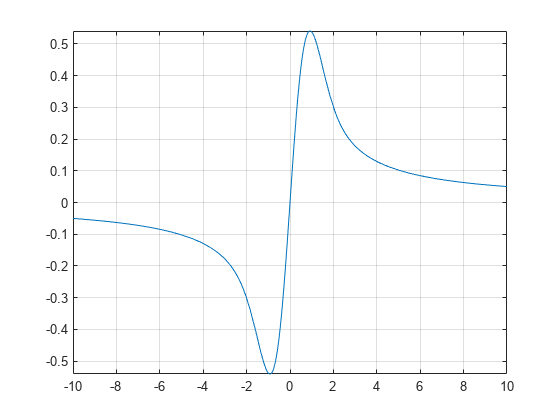dawson
Dawson 적분
설명
예제
숫자형 인수 및 기호 인수에 대한 Dawson 적분
dawson은 해당 인수에 따라 부동소수점 결과를 반환할 수도 있고 정확한 기호 결과를 반환할 수도 있습니다.
다음 숫자에 대해 Dawson 적분을 계산합니다. 이러한 숫자는 기호 객체가 아니므로 dawson은 부동소수점 결과를 반환합니다.
A = dawson([-Inf, -3/2, -1, 0, 2, Inf])
A =
0 -0.4282 -0.5381 0 0.3013 0기호 객체로 변환된 숫자에 대해 Dawson 적분을 계산합니다. 여러 기호 숫자(즉, 정확한 숫자 표현)에 대해 dawson은 계산되지 않은 기호 호출을 반환합니다.
symA = dawson(sym([-Inf, -3/2, -1, 0, 2, Inf]))
symA = [ 0, -dawson(3/2), -dawson(1), 0, dawson(2), 0]
vpa를 사용하여 부동소수점 숫자로 기호 결과를 근사합니다.
vpa(symA)
ans = [ 0,... -0.42824907108539862547719010515175,... -0.53807950691276841913638742040756,... 0,... 0.30134038892379196603466443928642,... 0]
Dawson 적분 플로팅하기
구간 -10~10에 대해 Dawson 적분을 플로팅합니다.
syms x fplot(dawson(x),[-10 10]) grid on

Dawson 적분을 포함하는 표현식 처리하기
diff, limit 등과 같은 여러 함수는 dawson을 포함하는 표현식을 처리할 수 있습니다.
Dawson 적분의 1계 도함수와 2계 도함수를 구합니다.
syms x diff(dawson(x), x) diff(dawson(x), x, x)
ans = 1 - 2*x*dawson(x) ans = 2*x*(2*x*dawson(x) - 1) - 2*dawson(x)
dawson을 포함하는 다음 표현식의 극한을 구합니다.
limit(x*dawson(x), Inf)
ans = 1/2
입력 인수
세부 정보
팁
dawson(0)은0을 반환합니다.dawson(Inf)는0을 반환합니다.dawson(-Inf)는0을 반환합니다.
버전 내역
R2014a에 개발됨